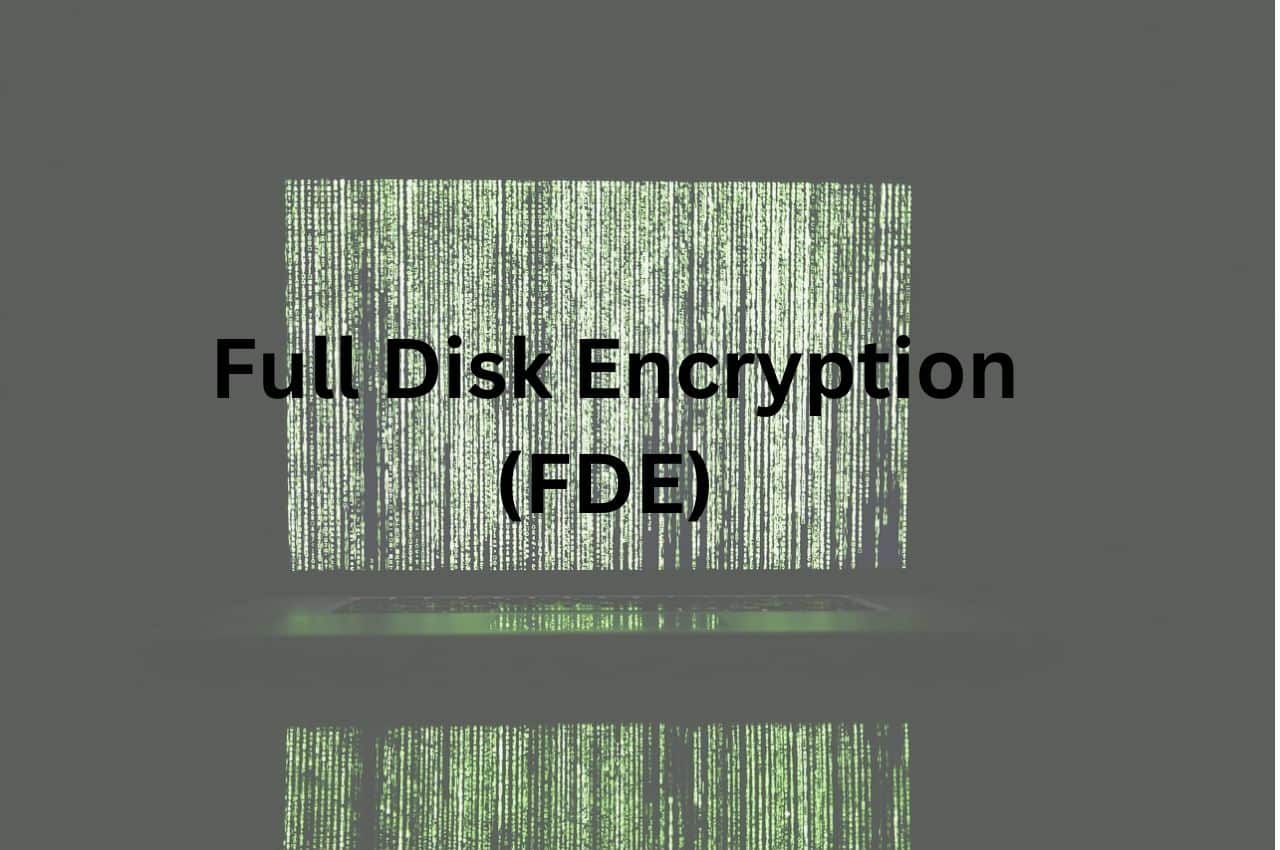Contents
- 1 Introduction to Full Disk Encryption (FDE)
- 2 Types of FDE and their Differences
- 3 How FDE Protects Data from Unauthorized Access?
- 4 Importance of FDE in Data Security
- 5 Implementing FDE: Best Practices and Tips
- 6 Challenges and Limitations of FDE
- 7 Future of FDE in the World of Cybersecurity
- 8 Conclusion
Introduction to Full Disk Encryption (FDE)
In an increasingly interconnected world where digital threats loom large, protecting sensitive data has become paramount. Whether you’re a business owner safeguarding customer information or an individual concerned about personal privacy, securing your valuable data is critical. This is where Full Disk Encryption (FDE) steps in as a powerful ally.
Imagine a fortress with impenetrable walls and guards stationed at every corner – that’s the protection FDE offers for your data. It ensures that even if unauthorized individuals gain access to your device or storage media, they won’t be able to decipher the encrypted contents, leaving them scratching their heads without any valuable information.
But what exactly is Full Disk Encryption? How does it work? And why should you consider implementing it for robust data security? Let’s dive deeper into the realm of FDE and discover its significance in fortifying your digital stronghold.
Types of FDE and their Differences
Full Disk Encryption (FDE) is crucial when securing sensitive data. It ensures that all the information stored on a device’s hard drive is encrypted and protected from unauthorized access. But what are the different types of FDE available? Let’s explore!
1. Software-based FDE: This type of encryption relies on software applications installed on the operating system to encrypt the entire disk. It provides flexibility as it can be implemented on various platforms but may have performance implications.
2. Hardware-based FDE: Unlike software-based encryption, hardware-based FDE utilizes a dedicated cryptographic chip or Trusted Platform Module (TPM) integrated into the device’s motherboard. This offers enhanced security and better performance since encryption/decryption tasks are offloaded to specialized hardware.
3. Self-encrypting drives (SEDs): SEDs combine software and hardware components by directly integrating an encryption engine into the drive. They offer seamless integration with existing systems while providing robust protection for data at rest.
Each type of FDE has its strengths and weaknesses, so choosing the right one depends on security requirements, compatibility with existing infrastructure, and performance considerations.
It is important to note that regardless of which type you choose, implementing robust authentication methods such as passwords or biometrics is essential to prevent unauthorized access, even if someone gains physical possession of your encrypted device.
Understanding the differences between software-based FDE, hardware-based FDE, and self-encrypting drives helps organizations decide which solution best suits their needs regarding the security level required and operational efficiency desired.
Full Disk Encryption (FDE) is a robust security measure crucial in safeguarding data from unauthorized access. By encrypting all the contents of a disk, FDE ensures that even if attackers gain physical or remote access to the device, they cannot view or extract sensitive information.
One-way FDE accomplishes this is through encryption algorithms that scramble the data stored on the disk. This means that all data appears gibberish without the encryption key, typically required during boot-up or log-in. Even if someone can bypass other security measures and access the encrypted disk, they won’t be able to decipher its contents.
Another important aspect of FDE is its ability to protect against offline attacks. If a laptop or hard drive containing encrypted data falls into the wrong hands, FDE ensures those files remain inaccessible unless decrypted with the proper credentials.
Furthermore, FDE provides continuous protection throughout a system’s lifecycle. Once enabled, it automatically encrypts any new files saved on the disk and decrypts them when accessed by authorized users. This seamless integration helps maintain consistent security and prevents accidental exposure of sensitive information.
In addition to protecting against unauthorized access, FDE also guards against unauthorized modifications of system files. Any attempt at tampering with critical operating system components requires decryption first—a significant deterrent for potential attackers aiming to manipulate system functionality.
Entire Disk Encryption is a robust safeguard for valuable data by rendering it unreadable and undecipherable without authorization. Its comprehensive coverage and continuous protection make it essential for ensuring strong data security across various devices and industries.
Importance of FDE in Data Security
In today’s digital age, data security is of utmost importance. With cyber threats becoming more sophisticated daily, businesses and individuals must prioritize protecting sensitive information. This is where Full Disk Encryption (FDE) comes into play.
FDE is a powerful defence against unauthorized access to data stored on laptops, desktops, and mobile devices. By encrypting the entire hard drive or storage device, FDE ensures that the data remains unintelligible and inaccessible even if it falls into the wrong hands.
One key benefit of FDE is its ability to protect against physical theft or loss of devices. In cases where laptops are stolen or misplaced, encryption prevents unauthorized users from accessing confidential files, potentially causing irreparable damage.
Moreover, FDE safeguards sensitive information during transmission over networks or shared with others. It ensures that the encrypted data cannot be deciphered even if it is intercepted during transit without the proper decryption keys.
Another critical aspect is compliance with regulations regarding data protection and privacy. Many industries have legal requirements for safeguarding customer information; failure to comply can result in severe penalties and reputational damage. Implementing FDE helps organizations meet these obligations by ensuring that all stored data remains secure.
Furthermore, using an additional layer of authentication alongside FDE significantly enhances security measures. Multi-factor authentication adds extra protection by requiring users to provide multiple credentials before accessing encrypted data.
Entire Disk Encryption is crucial in maintaining confidentiality and integrity when safeguarding sensitive information. As cyber threats evolve rapidly, implementing robust encryption technologies like FDE becomes increasingly vital for organizations aiming to avoid potential breaches.
Implementing FDE: Best Practices and Tips
Implementing Full Disk Encryption (FDE) is a crucial step in ensuring the security of your data. By encrypting the entire disk, FDE protects sensitive information from unauthorized access. However, implementing FDE requires careful consideration and adherence to best practices to maximize its effectiveness.
First and foremost, choosing a robust encryption algorithm for your FDE solution is essential. Industry-standard algorithms such as AES-256 offer strong protection against brute-force attacks. Additionally, regularly updating the encryption software ensures that any vulnerabilities are patched promptly.
When implementing FDE, creating unique and strong passwords or passphrases for authentication is vital. Avoid using easily guessable passwords or reusing them across multiple accounts or systems. Implementing multi-factor authentication (MFA) can enhance security by requiring additional verification steps.
Regularly backing up encrypted data is another best practice when implementing FDE. In case of system failures or data corruption incidents, having backups ensures you do not lose critical information permanently.
Proper planning and communication are vital to ensuring smooth implementation of FDE across an organization’s devices. Create a deployment plan detailing which devices will be encrypted first and establish clear guidelines for employees on securely managing their encrypted devices.
Furthermore, providing comprehensive training sessions on the importance of FDE and guiding employees through enabling encryption can help mitigate potential user errors that may compromise data security.
Regularly auditing your system’s encryption status is essential to promptly identify any weaknesses or non-compliance issues. Conduct regular vulnerability assessments and penetration testing to ensure your encryption solution remains effective against evolving threats.
By following these best practices when implementing Full Disk Encryption (FDE), organizations can significantly strengthen their overall data security posture while safeguarding sensitive information from unauthorized access.
Challenges and Limitations of FDE
While Full Disk Encryption (FDE) is a powerful tool in data security, it does come with its fair share of challenges and limitations. One major challenge is the potential impact on system performance. Encrypting and decrypting large amounts of data can cause a slowdown in processing speed, especially on older hardware or devices with limited resources.
Another limitation of FDE lies in its inability to protect against certain types of attacks. While FDE ensures that data remains encrypted when not actively accessed, it cannot prevent unauthorized access if an attacker gains physical access to the device while powered on.
Additionally, implementing FDE across an organization’s infrastructure can be complex. It requires careful planning, coordination, and potentially significant financial investment. This can be particularly challenging for larger organizations with multiple operating systems and diverse hardware configurations.
Furthermore, user education and awareness are crucial when using FDE. If users forget their encryption passphrase or mishandle their encryption keys, valuable data could become inaccessible permanently.
There is also the risk of relying solely on FDE without implementing other layers of security measures, such as solid authentication protocols or network-level protections. It’s important to remember that while FDE provides excellent protection for stored data at rest, additional safeguards should still be considered to defend against other potential threats.
Future of FDE in the World of Cybersecurity
As technology continues to evolve at a rapid pace, so does the world of cybersecurity. With cyber threats becoming increasingly sophisticated, organizations must stay one step ahead when protecting their sensitive data. This is where Full Disk Encryption (FDE) plays a vital role.
In the future, we expect FDE to become even more advanced and integrated into everyday devices. As more industries embrace digital transformation and cloud computing, the need for robust encryption solutions will only grow. FDE will likely be embedded within operating systems and hardware, ensuring that data remains secure from the moment it is created.
Advancements in quantum computing also pose new challenges for data security. However, experts predict that FDE will adapt to these changes by incorporating post-quantum cryptography algorithms resistant to quantum attacks.
Furthermore, with the rise of Internet of Things (IoT) devices and a greater reliance on interconnected systems, FDE must extend its protection beyond traditional computers and servers. We anticipate FDE being implemented in smart homes, autonomous vehicles, healthcare devices – essentially any device that collects or stores sensitive information.
Additionally, as regulations around data privacy continue to tighten globally (such as GDPR), businesses must prioritize encryption as an essential component of their cybersecurity strategy. Failure to do so could result in severe financial penalties and reputational damage.
Conclusion
Entire Disk Encryption (FDE) ensures data security by protecting sensitive information from unauthorized access. With the increasing prevalence of cyber threats and data breaches, implementing FDE has become more important than ever.
Throughout this article, we have explored various aspects of FDE, including its types, benefits, implementation best practices, and challenges. We have seen how FDE encrypts the entire disk drive and renders the data unreadable without the proper encryption key.
By employing FDE solutions, individuals and organizations can safeguard their valuable data against theft or exposure in case of device loss or theft. This provides peace of mind, knowing that even if someone gains physical access to their devices or storage media, they won’t be able to access the encrypted contents.
However, it is essential to acknowledge that while FDE provides robust protection for stored data at rest on a device’s hard drive or SSDs when powered off or locked, it does not protect against attacks targeting live systems with active user sessions. Additionally, specific vulnerabilities can still exist within an operating system or applications on top of encrypted disks.
Looking ahead into the future of cybersecurity trends and advancements in technology, it is expected that Full Disk Encryption will continue to evolve alongside other security measures. As new threats emerge and attackers devise sophisticated methods to gain unauthorized access to sensitive information, updates and enhancements will likely be made to existing encryption algorithms and protocols.
Remember: Data is one of our most precious assets; let us take every necessary step to safeguard it.
Latest Posts!



